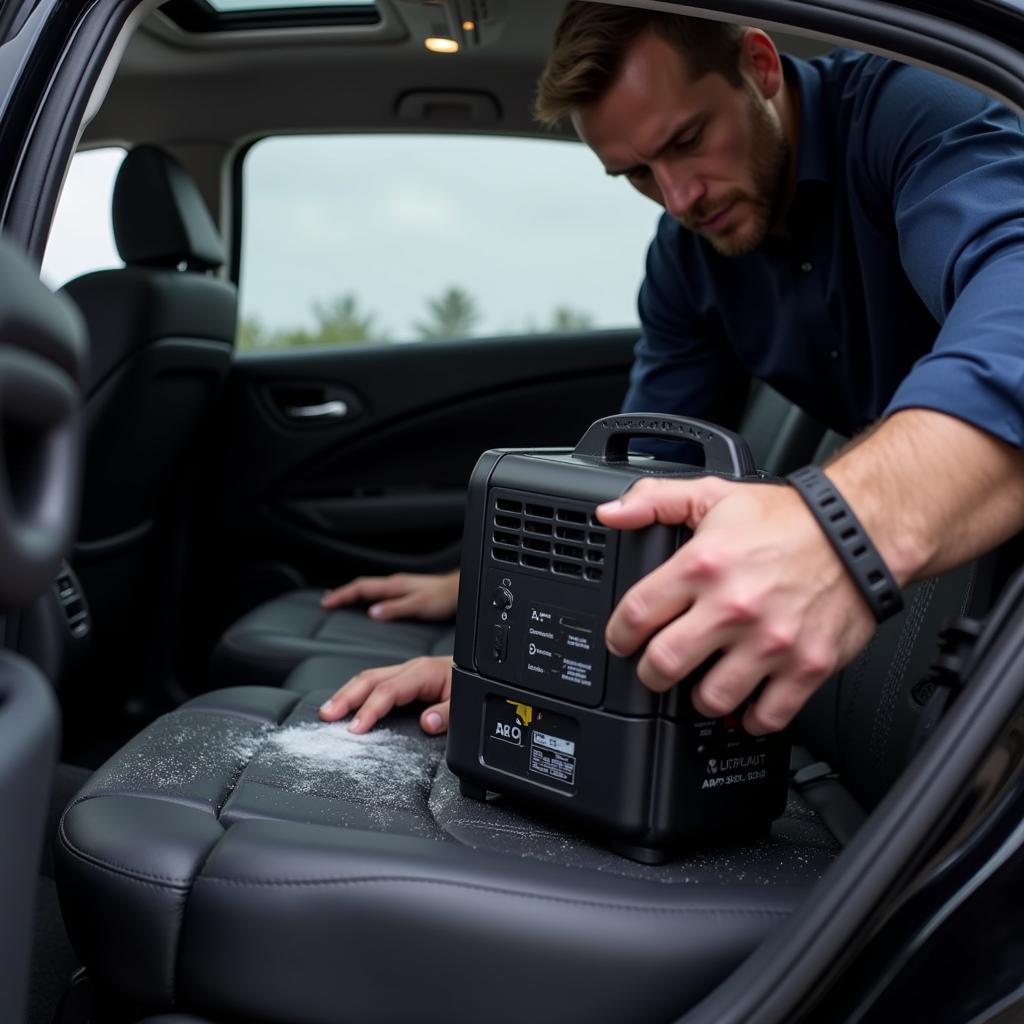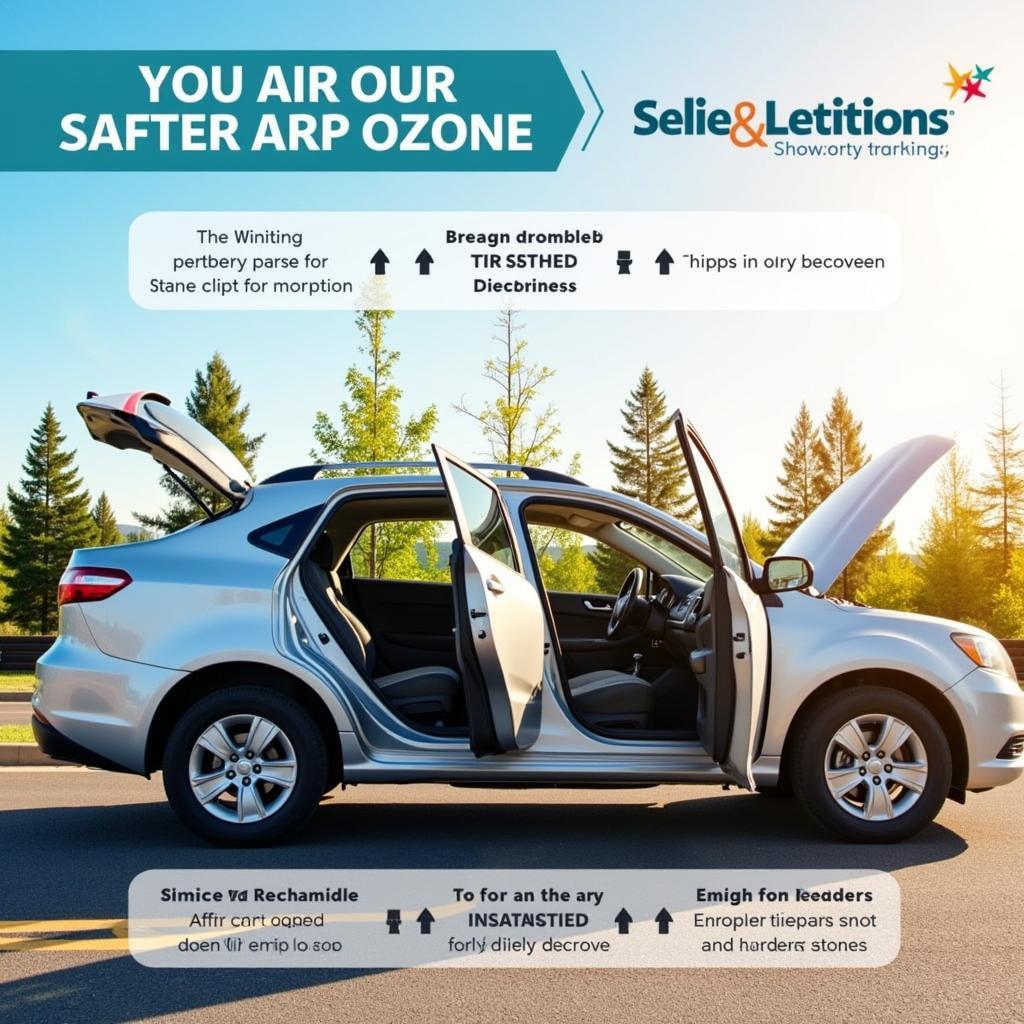Ozone generators are powerful tools in car detailing, effectively eliminating stubborn odors like smoke, mildew, and pet smells. But how long should you air out a car after using an ozone generator? This is a crucial question for both detailers and car owners to ensure safety and effectiveness. Let’s dive into the details.
Understanding Ozone and its Effects
Ozone (O3) is a highly reactive gas that oxidizes odor-causing molecules, effectively neutralizing them. While highly effective, it’s essential to understand that ozone can be harmful if inhaled in high concentrations. Therefore, proper ventilation after ozone treatment is paramount. Knowing how long to air out your car after ozone treatment is not just about eliminating the ozone smell, but also ensuring a safe environment for yourself and your clients.
After the initial ozone treatment, some residual ozone will remain in the car’s interior. The time required for this residual ozone to dissipate depends on several factors, including the size of the vehicle, the ozone generator’s output, and the ambient temperature. Generally, smaller vehicles will require less airing-out time than larger ones. A higher ozone output means a longer wait time, and warmer temperatures can help speed up the process.
 Car Detailing: Ozone Generator in Action
Car Detailing: Ozone Generator in Action
Factors Influencing Airing-Out Time
Several factors affect how long you need to air out a car after ozone treatment. The ozone generator’s strength is a major factor. More powerful generators require longer airing-out periods. Similarly, the size of the vehicle’s interior plays a significant role. A larger SUV will naturally take longer to air out than a compact car. Ambient temperature also influences the process. Warmer temperatures can accelerate ozone dissipation. Finally, the severity of the odor being treated can also be a factor. Strong, ingrained odors might necessitate longer ozone exposure and, consequently, longer airing-out times.
It’s important to be patient during the airing-out process. Rushing the process can lead to exposure to residual ozone, which can cause respiratory irritation. Always err on the side of caution and allow ample time for the ozone to completely dissipate.
 Car Detailing: Airing Out Car After Ozone Treatment
Car Detailing: Airing Out Car After Ozone Treatment
General Guidelines for Airing Out
While specific airing-out times vary, a general guideline is to allow at least 2-4 hours for smaller vehicles and 4-6 hours for larger vehicles after using an ozone generator. However, it’s always best to err on the side of caution. You can use an ozone detector to measure the ozone levels and ensure they’ve returned to safe levels before re-entering the vehicle.
“Always prioritize safety when using ozone generators,” advises John Smith, Certified Car Detailing Specialist at capital car detailing madison wi. “Investing in an ozone detector can provide peace of mind and ensure a safe environment for both you and your clients.”
How to Speed Up the Airing-Out Process
Opening all the doors and windows is the most effective way to air out a vehicle. Running the car’s ventilation system on fresh air mode can also help circulate the air and expedite the process. Additionally, placing a fan inside the vehicle can further enhance air circulation and accelerate ozone dissipation.
Ensuring Complete Ozone Removal
After the airing-out period, it’s a good practice to check for any lingering ozone smell. If you can still detect the distinct, sharp smell of ozone, continue airing out the car for longer. Never re-enter the vehicle until the ozone smell is completely gone.
“Remember, a little patience goes a long way when dealing with ozone,” adds Jane Doe, Senior Car Detailing Instructor. “It’s better to wait a bit longer than to risk exposure to residual ozone.”
Conclusion
Using an ozone generator for car detailing can effectively eliminate stubborn odors, but proper airing out is crucial for safety. Following these guidelines and understanding the factors that influence airing-out time will ensure a safe and effective detailing process. Remember, patience is key to achieving optimal results and maintaining a safe environment.
FAQ
- How can I tell if the ozone levels are safe? The best way is to use an ozone detector.
- What are the signs of ozone exposure? Symptoms can include coughing, throat irritation, and shortness of breath.
- Can I use an ozone generator in a closed garage? No, always use an ozone generator in a well-ventilated area.
- How often should I use an ozone generator for car detailing? Only when necessary to eliminate stubborn odors.
- Is ozone safe for car interiors? Yes, when used correctly and aired out properly.
- Can ozone damage the car’s electronics? Generally, no, but it’s best to consult the car’s manual.
- What are alternatives to ozone generators for odor removal? Steam cleaning and baking soda treatments are some alternatives.
Need further assistance? Explore these related articles on our website.
Looking for expert car detailing services? Contact us via WhatsApp: +1(641)206-8880, Email: [email protected]. We have a 24/7 customer support team ready to assist you.

Leave a Reply